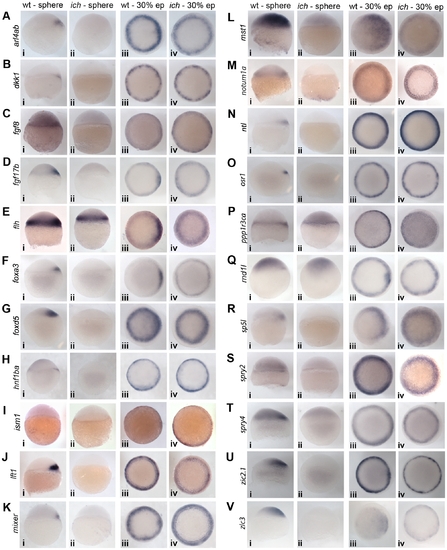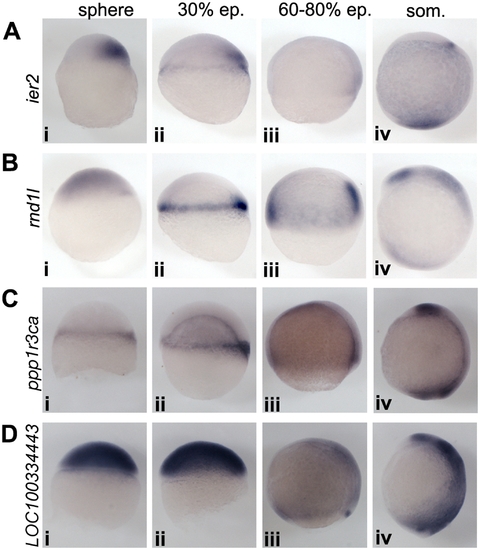- Title
-
Full transcriptome analysis of early dorsoventral patterning in zebrafish
- Authors
- Fodor, E., Zsigmond, A., Horváth, B., Molnár, J., Nagy, I., Tóth, G., Wilson, S.W., and Varga, M.
- Source
- Full text @ PLoS One
|
Expression of pan-mesodermal candidate genes. The majority of the identified genes show early dorsal expression in wild type embryos and lack thereof in ich controls. This is followed by a second wave of circumferential, mesodermal expression, which could be detected in both genetic backgrounds. An interesting exception is flh, which shows a somewhat counterintuitive expression dynamics: a very strong circumferential expression (complemented by strong dorsal signal in wild type embryos) can be detected as early as late sphere stage (Ei, Eii), but this expression becomes significantly weaker by 30% epiboly, except in the dorsal side of wild type embryos (Eiii, Eiv). Sphere stage embryos are shown from a lateral view, whereas ~30% epiboly stage embryos are presented from an animal view (dorsal to the right in both cases). |
|
Expression of other candidate genes. The majority of genes in this category can be characterized by a “dorsal-only” expression pattern: they are expressed both at sphere and at 30% epiboly stages in the dorsal side of wild type controls and are absent from ich embryos. The exception is rasl11b which shows a strong dorsal, and a fainter ubiquitous expression at sphere stage in wild types (Fi), but by 30% epiboly it is absent from the dorsal side and expression can be detected only ventrally (Fiii). Accordingly, in ich embryos lacking dorsal induction, faint ubiquitous expression (Fii) becomes progressively stronger during development (Fiv). Sphere stage embryos are shown from a lateral view, whereas ~30% epiboly stage embryos are presented from an animal view (dorsal to the right in both cases). EXPRESSION / LABELING:
|
|
Expression patterns of newly characterized genes. (A) ier2 expression starts early in the future dorsal side, persists until early mid-gastrulation, then fades away, and becomes detectable only during somitogenesis in a stripe in the hindbrain area, and in the tailbud. (B) rnd1l expression is weakly upregulated in all the blastomeres after MBT, and it is expressed at higher levels in a few dorsal precursors. Later the expression becomes restricted in the mesoderm (both axial and non-axial), where it is progressively downregulated. During somitogenesis two prominent neural expression domains appear: in the eyefield and in the hindbrain. (C) ppp1r3ca expression starts at the dorsal edge of the embryo, and later it is upregulated in a narrow stripe around the germring. Expression weakens during late gastrula stages, but it will be upregulated during somitogenesis in the anterior forebrain and in the posterior tailbud regions. (D) LOC100334443 expression is strongly upregulated after the onset of zygotic transcription. During gastrulation it becomes restricted to the ectoderm, where it is gradually downregulated, except in the dorsal forerunner cells. During somitogenesis expression is also prominent in the neurectoderm, especially in the hindbrain. All embryos are shown from lateral view, dorsal to the right. EXPRESSION / LABELING:
|
|
Genes with stochastic early expression. Genes belonging to this class show stochastic expression at the onset of the zygotic transcription. We could detect clusters of cells both in wild type and ich embryos that upregulated these particular genes, but no clear pattern emerged. For aplnrb (A–F) and isg15 (G–N), the expression pattern later became more coherent, and localized around the germring. Interestingly, although no clear expression pattern emerged, foxo3b expression in general appeared higher in wild type embryos (O–V). Later stages of foxo3b expression in wild type embryos also showed stochastic and varying expression patterns (A′–H′). All sphere and 30% epiboly stage embryos are shown from an animal view. Shield, 70% epiboly and bud stage embryos are shown from a lateral view, with dorsal to the right. |




